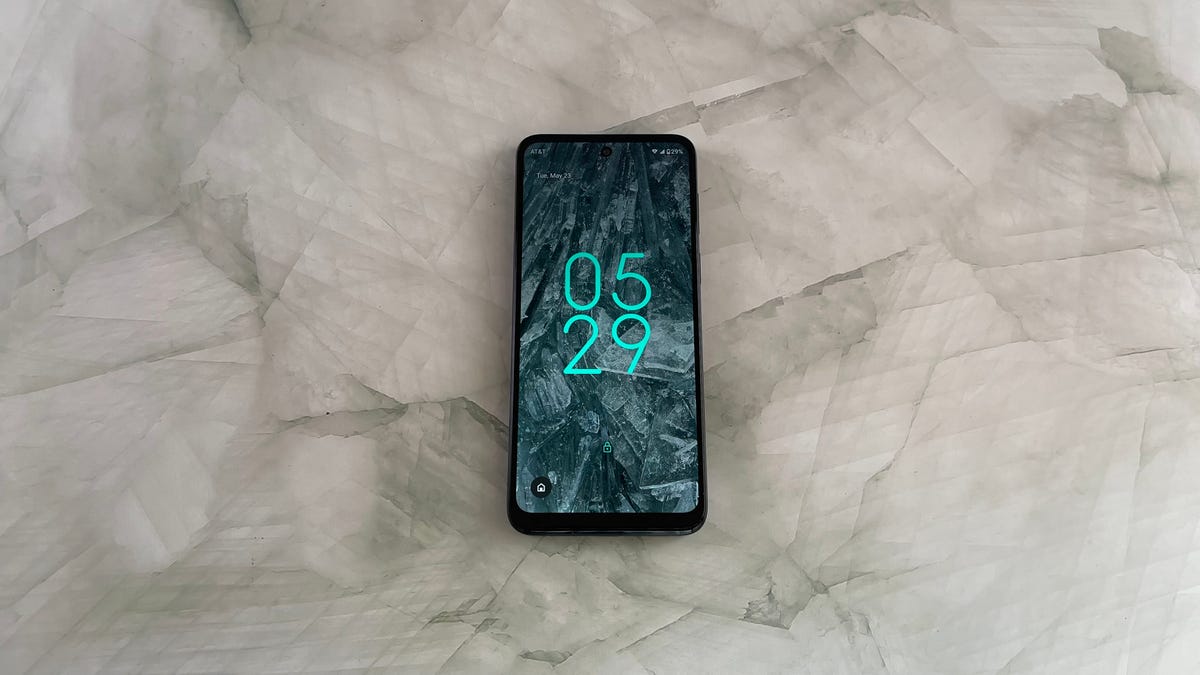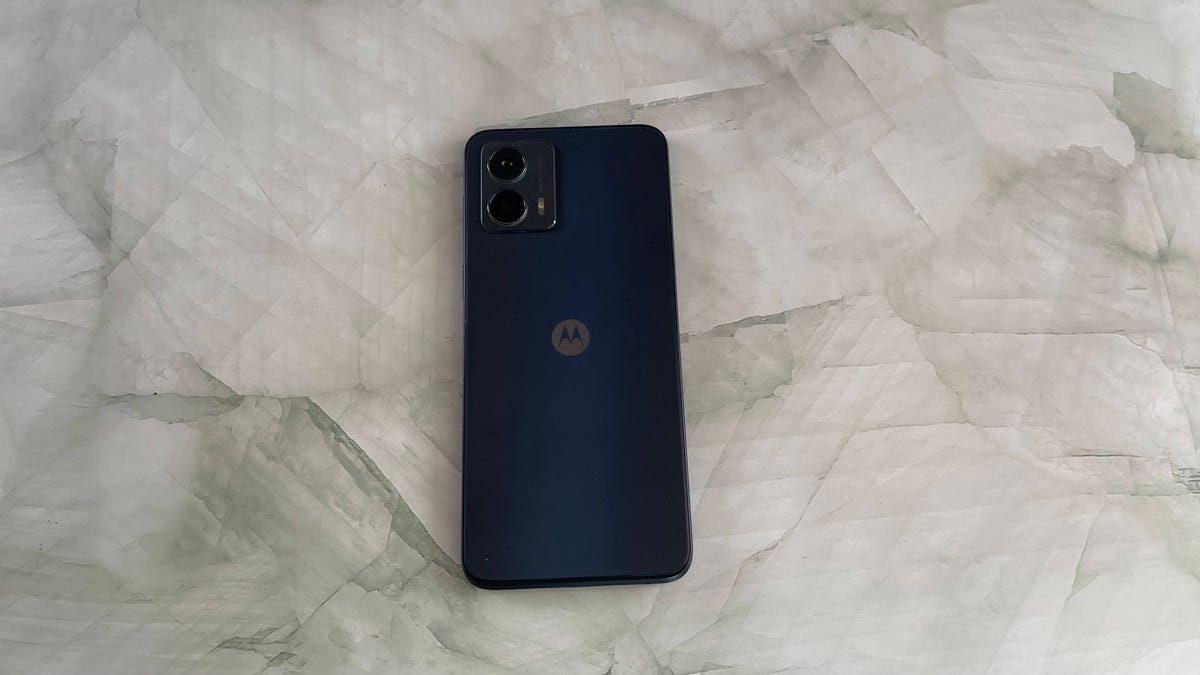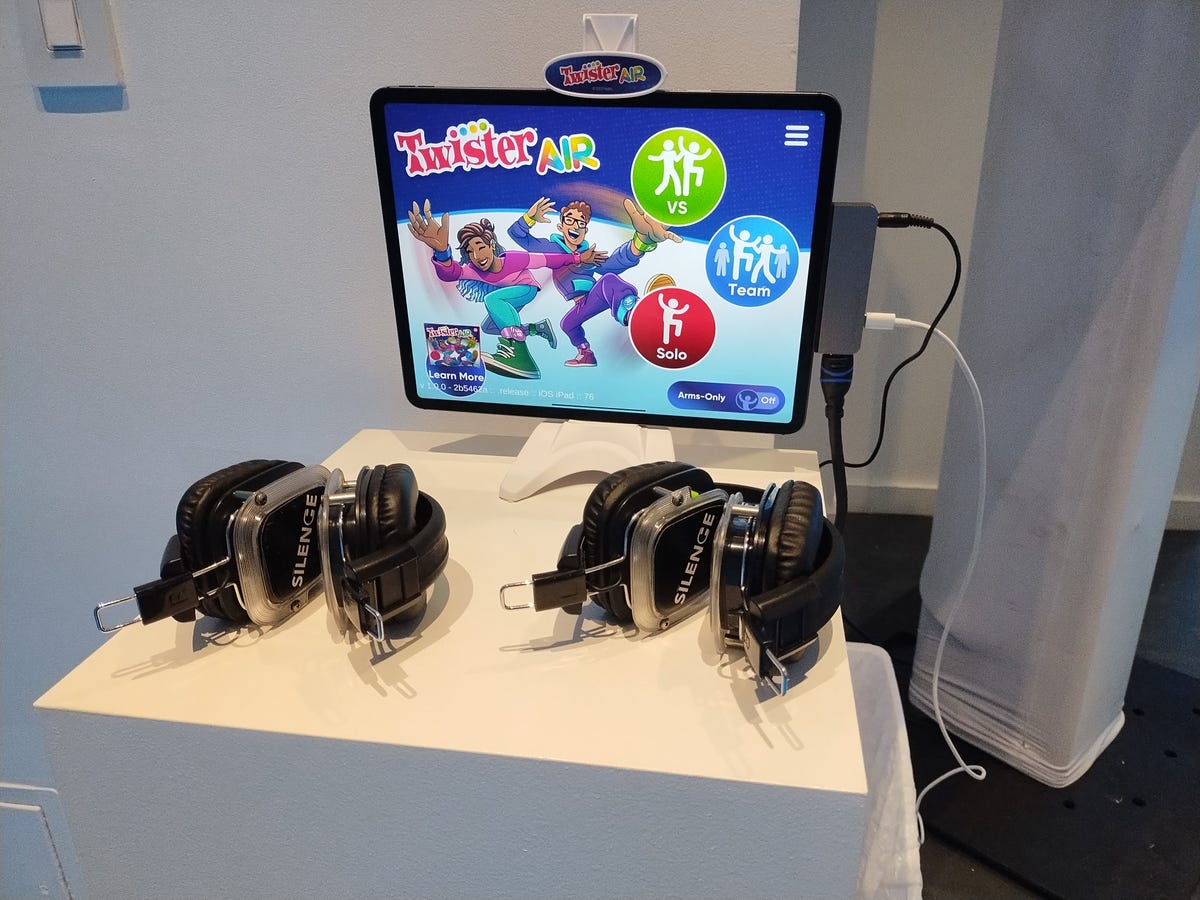Technologies
Moto G 5G (2023) Hands-On: Are the Trade-Offs Worth the Lower $250 Price?
The Moto G gets reinvented with a cheaper price, and it shows.

Advertiser Disclosure
The $250 Moto G 5G marks a big reimagining of the phone since last year’s more-expensive $400 model. This year’s Moto G 5G scales back on storage and cameras to help hit its lower price but steps up the refresh rate on its 6.5-inch display to a smooth 120Hz. All that, while keeping the 5,000mAh battery and its roughly two-day battery life, should make the phone a decent value for its price.
The Moto G 5G has 4GB of memory, runs on a Snapdragon 480 Plus 5G chip and comes with 128GB of storage. This is a decent amount of storage space for this price and can be expanded up to 1TB with a microSD card. The phone’s stereo speakers and headphone jack are also quite nice for when I watch videos or listen to music. It ships with Android 13, and like other Moto G phones, will get only one major software update to Android 14 along with three years of security updates
I spent a few days with the Moto G 5G so far, and, while it looks and feels like it’s fallen down a few rungs of the price tier, the phone might meet enough essential needs to satisfy most people. However, by no means does it punch above its weight. The Moto G 5G has 4GB of memory, runs on a Snapdragon 480 Plus 5G chip and comes with 128GB of storage. This is a decent amount of storage space for the price and can be expanded up to 1TB with a microSD card. The phone’s stereo speakers and headphone jack are also quite nice for when I watch videos or listen to music. It ships with Android 13, and like other Moto G phones, will get only one major software update to Android 14 along with three years of security updates.

The Moto G 5G has a main 48-megapixel camera and a 2-megapixel macro camera.
However, when testing other features, I can’t help but compare this phone to the slightly more expensive $300 Moto G Power 5G — which includes quite a bit more for that extra $50. For instance, the Moto G 5G’s 6.5-inch display runs at a 720p resolution. Even though that screen animates smoothly with its 120Hz refresh rate, I find that the lower-resolution makes photos and videos look rather plain. The Power 5G runs at a 1,080p resolution at the same refresh rate, and in my review of that phone the display was a particular highlight.
Performance also seems to take a noticeable hit during my early tests, which could be attributable to the phone having 4GB of memory compared with the 6GB available on the Power 5G. Often when I test phones, during casual use I play games while taking calls or texting. I find that when a call comes through while I’m playing a game, in this instance Marvel Snap, that the game needs to reload itself after I answer the call. Lighter multitasking, however, has been fine, for instance reading news articles while I’m listening to music has not led to any noticeable issues.
The Moto G 5G also moves down from three cameras on last year’s model to two, with this year’s phone including a 48-megapixel main camera and a 2-megapixel macro camera. This is an area that cheaper phones often struggle, and my early photos taken by the Moto G 5G don’t change that opinion. Like other cheaper phones, photos taken in outdoor environments or indoor locations with good lighting come out OK, but without much detail.

Outdoor photo taken on the Moto G 5G of the Public Theater.

Indoor photo taken on the Moto G 5G at a Twister Air demo event.
The 8-megapixel front-facing camera is similarly serviceable, but photos look a little plain.

Front-facing camera photo taken on the Moto G 5G.
I’ll reserve judgment after I have taken the Moto G 5G through more photo scenes, but my early indoor photos are comparable to the Moto G Power 5G — which is to say that they are fairly blurry and lack detail. Photos are usable but more for quick group chats and social posts.

A cocktail photo taken at a friend’s house on the Moto G 5G.
The Moto G 5G’s 5,000mAh battery, however, easily lasted two days during my early tests, matching the performance that I saw on the Moto G Power 5G and the $200 Moto G Stylus. As we continue to test phones in the $300 price range, it has been comforting to see the 5,000mAh battery become a standard feature in 2023. However, I hope Motorola finds a way to speed up charging, as the Moto G 5G’s 15-watt max speed takes about 90 minutes to charge from 4% to 88%. It’s not awful, but is slow when compared with the 33-watt charging included on comparable phones like the OnePlus N300 and OnePlus N20.
Motorola has been releasing several phones over the last few weeks, with the Moto G 5G arriving alongside the $800 Motorola Edge Plus. The Moto G 5G appears to be offering a middle ground between the 4G-only Moto G Stylus and the Moto G Power. The main question as I continue testing is whether this phone’s trade-offs are worth the lower price, or if someone searching for a deal should consider paying slightly less for the Stylus or more for the Power.
Technologies
Before You Order a $20K Home Robot, There’s Something You Should See
It’s designed to do your chores — with some help from folks behind the curtain.

The robot stands 5 feet 6 inches tall, weighs about as much as a golden retriever and is nearly the price of a brand-new budget car.
This is Neo, the humanoid robot. It’s billed as a personal assistant you can talk to and eventually rely on to handle everyday tasks, including loading your dishwasher and folding your laundry.
Neo doesn’t come cheap: it’ll cost you $20,000. And even then, you’ll still have to train this new home bot, and possibly need a remote assist as well.
If that still sounds enticing, preorders are now open (for $200 down). You’ll be signing up as an early adopter for what Neo’s maker, a California-based company called 1X, is calling a «consumer-ready humanoid.» That’s opposed to other humanoids under development from the likes of Tesla and Figure, which are, for the moment at least, more focused on factory environments.
Neo is a whole order of magnitude different from robot vacuums like those from Roomba, Eufy and Ecovacs, and embodies a long-running sci-fi fantasy of robot maids and butlers doing chores and picking up after us. If this is the future, read on for more of what’s in store.
Don’t miss any of our unbiased tech content and lab-based reviews. Add CNET as a preferred Google source.
What the Neo robot can do around the house
The pitch from 1X is that Neo can do all manner of household chores: fold laundry, run a vacuum, tidy shelves and bring in the groceries. It can open doors, climb stairs and even act as a home entertainment system.
Neo appears to move smoothly, with a soft, almost human-like gait, thanks to 1X’s tendon-driven motor system that gives it gentle motion and impressive strength. The company says it can lift up to 154 pounds and carry 55 pounds, but it is quieter than a refrigerator. It’s covered in soft materials and neutral colors, making it look less intimidating than metallic prototypes from other companies.
The company says Neo has a 4-hour runtime. Its hands are IP68-rated, meaning they’re submersible in water. It can connect via Wi-Fi, Bluetooth and 5G. For conversation, it has a built-in large language model (LLM), the same sort of AI technology that powers ChatGPT and Gemini.
The primary way to control the Neo robot will be by speaking to it, just as if it were a person.
Still, Neo’s usefulness today depends heavily on how you define useful. The Wall Street Journal’s Joanna Stern got an up-close look at Neo at 1X’s headquarters and found that, at least for now, it’s largely teleoperated, meaning a human often operates it remotely using a virtual-reality headset and controllers.
«I didn’t see Neo do anything autonomously, although the company did share a video of Neo opening a door on its own,» Stern wrote last week. 1X CEO Bernt Børnich reportedly told her that Neo will do most things autonomously in 2026, though he also acknowledged that the quality «may lag at first.»
The company’s FAQ says that if there’s a chore request Neo doesn’t know how to accomplish, you can schedule an expert from 1X to help the robot «learn while getting the job done.»
What you need to know about Neo and privacy
Part of what early adopters are signing up for is to allow Neo to learn from their environment, so that future versions can operate more independently.
That learning process raises questions about privacy and trust. The robot uses a mix of visual, audio and contextual intelligence — meaning it can see, hear and remember interactions with you in your home.
«If you buy this product, it is because you’re OK with that social contract,» Børnich told the Journal. «It’s less about Neo instantly doing your chores and more about you helping Neo learn to do them safely and effectively.»
Neo’s reliance on human operation behind the scenes prompted a response from John Carmack, a computer industry luminary known for his work with VR systems and the lead programmer of classic video games, including Doom and Quake.
«Companies selling the dream of autonomous household humanoid robots today would be better off embracing reality and selling ‘remote operated household help’,» he wrote in a post on the X social network.
1X says it’s taking steps to protect your privacy: Neo listens only when it recognizes it’s being addressed, and its cameras will blur out humans. You can restrict Neo from entering or viewing specific areas of your home, and the robot will never be teleoperated without owner approval, the company says.
But inviting an AI-equipped humanoid to observe your home life isn’t a small step.
The first units are expected to ship to customers in the US in 2026. There is a $499 monthly subscription alternative to the $20,000 full purchase price, although it will be available at an unspecified later date. A broader international rollout is promised for 2027.
Neo’s got a long road ahead of it to live up to the expectations set by Rosie the Robot in The Jetsons way back when. But this is no Hanna-Barbera cartoon. What we’re seeing now is a much more tangible harbinger of change.
Technologies
I Turned Off These 3 iOS Settings and My iPhone Battery Life Tripled
If you want your iPhone battery to last longer, these are the settings you should disable immediately.

Your iPhone is a crucial part of your routine. From staying in touch with friends or family, navigating around traffic snarls and snapping cute photos of your pets, you’re likely using it all day long. However, that can become tricky if your battery is down to low levels before you even leave the office. While phone batteries will degrade over time, it doesn’t mean you need to employ low power mode just to keep your phone from dying.
Your iPhone has a few key settings that are notorious for draining your battery in the background. The good news is, you can turn them off. Instead of watching your battery percentage plummet at the worst possible moment, a few simple tweaks will give you hours of extra life.
Before you even think about buying a new phone, check your Battery Health menu (anything above 80% is decent) and then turn off these three power-hungry settings. It’s the easiest way to make your iPhone battery last longer, starting right now.
Don’t miss any of our unbiased tech content and lab-based reviews. Add CNET as a preferred Google source.
Turn off widgets on your iPhone lock screen
All the widgets on your lock screen force your apps to automatically run in the background, constantly fetching data to update the information the widgets display, like sports scores or the weather. Because these apps are constantly running in the background due to your widgets, that means they continuously drain power.
If you want to help preserve some battery on iOS 18, the best thing to do is simply avoid widgets on your lock screen (and home screen). The easiest way to do this is to switch to another lock screen profile: Press your finger down on your existing lock screen and then swipe around to choose one that doesn’t have any widgets.
If you want to just remove the widgets from your existing lock screen, press down on your lock screen, hit Customize, choose the Lock Screen option, tap on the widget box and then hit the «—« button on each widget to remove them.
Reduce the motion of your iPhone UI
Your iPhone user interface has some fun, sleek animations. There’s the fluid motion of opening and closing apps, and the burst of color that appears when you activate Siri with Apple Intelligence, just to name a couple. These visual tricks help bring the slab of metal and glass in your hand to life. Unfortunately, they can also reduce your phone’s battery life.
If you want subtler animations across iOS, you can enable the Reduce Motion setting. To do this, go to Settings > Accessibility > Motion and toggle on Reduce Motion.
Switch off your iPhone’s keyboard vibration
Surprisingly, the keyboard on the iPhone has never had the ability to vibrate as you type, an addition called «haptic feedback» that was added to iPhones with iOS 16. Instead of just hearing click-clack sounds, haptic feedback gives each key a vibration, providing a more immersive experience as you type. According to Apple, the very same feature may also affect battery life.
According to this Apple support page about the keyboard, haptic feedback «might affect the battery life of your iPhone.» No specifics are given as to how much battery life the keyboard feature drains, but if you want to conserve battery, it’s best to keep this feature disabled.
Fortunately, it is not enabled by default. If you’ve enabled it yourself, go to Settings > Sounds & Haptics > Keyboard Feedback and toggle off Haptic to turn off haptic feedback for your keyboard.
For more tips on iOS, read about how to access your Control Center more easily and why you might want to only charge your iPhone to 95%.
Technologies
Today’s NYT Mini Crossword Answers for Sunday, Nov. 23
Here are the answers for The New York Times Mini Crossword for Nov. 23.

Looking for the most recent Mini Crossword answer? Click here for today’s Mini Crossword hints, as well as our daily answers and hints for The New York Times Wordle, Strands, Connections and Connections: Sports Edition puzzles.
Need some help with today’s Mini Crossword? It includes a Jimi Hendrix reference, which I appreciated. Read on for the answers. And if you could use some hints and guidance for daily solving, check out our Mini Crossword tips.
If you’re looking for today’s Wordle, Connections, Connections: Sports Edition and Strands answers, you can visit CNET’s NYT puzzle hints page.
Read more: Tips and Tricks for Solving The New York Times Mini Crossword
Let’s get to those Mini Crossword clues and answers.
Mini across clues and answers
1A clue: LinkedIn listing
Answer: JOB
4A clue: Planet with an average surface temperature of around 860°F
Answer: VENUS
6A clue: Written with a pen
Answer: ININK
7A clue: Sheer torment
Answer: AGONY
8A clue: «___ thoughts?»
Answer: ANY
Mini down clues and answers
1D clue: Block tower
Answer: JENGA
2D clue: «Red» vegetable that’s really purple, if you ask me
Answer: ONION
3D clue: Word with Bad or Bugs
Answer: BUNNY
4D clue: By way of
Answer: VIA
5D clue: «Excuse me while I kiss the ___» (Hendrix lyric that’s famously misheard)
Answer: SKY
-

 Technologies3 года ago
Technologies3 года agoTech Companies Need to Be Held Accountable for Security, Experts Say
-

 Technologies3 года ago
Technologies3 года agoBest Handheld Game Console in 2023
-

 Technologies3 года ago
Technologies3 года agoTighten Up Your VR Game With the Best Head Straps for Quest 2
-

 Technologies4 года ago
Technologies4 года agoBlack Friday 2021: The best deals on TVs, headphones, kitchenware, and more
-

 Technologies4 года ago
Technologies4 года agoVerum, Wickr and Threema: next generation secured messengers
-

 Technologies4 года ago
Technologies4 года agoGoogle to require vaccinations as Silicon Valley rethinks return-to-office policies
-

 Technologies4 года ago
Technologies4 года agoOlivia Harlan Dekker for Verum Messenger
-

 Technologies4 года ago
Technologies4 года agoiPhone 13 event: How to watch Apple’s big announcement tomorrow
